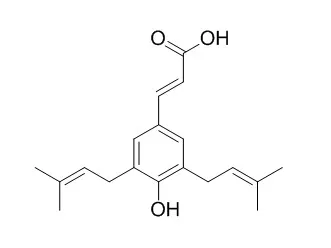| Description: |
Artepillin C shows antioxidant, anti-angiogenesis, and anti-tumor activities; it also shows anti-inflammatory effects mediated, at least in part, by prostaglandin E2 and nitric oxide inhibition through NF-κB modulation. Artepillin C activates the immune system, and possesses direct antitumor activity. Artepillin C can suppress alloreactive CD4 T cell responses in vitro, so it could be used as a potential immunosuppressant, either solely or as adjunct agent in treating graft versus host disease. Artepillin C promotes adipocyte differentiation and glucose uptake in part by direct binding to PPARγ, which could be the basis of the pharmacological benefits of green propolis intake in reducing the risk of type 2 diabetes. |
| In vitro: |
| Cancer detection and prevention, 1998,22(6):506-515. | | Apoptosis and suppression of tumor growth by artepillin C extracted from Brazilian propolis.[Reference: WebLink] |
METHODS AND RESULTS:
Artepillin C was extracted from Brazilian propolis. Artepillin C (3,5-diprenyl-4-hydroxycinnamic acid) has a molecular weight of 300.40 and possesses antibacterial activity. When Artepillin C was applied to human and murine malignant tumor cells in vitro and in vivo, Artepillin C exhibited a cytotoxic effect and the growth of tumor cells was clearly inhibited. The Artepillin C was found to cause significant damage to solid tumor and leukemic cells by the MTT assay, DNA synthesis assay, and morphological observation in vitro. When xenografts of human tumor cells were transplanted into nude mice, the cytotoxic effects of Artepillin C were most noticeable in carcinoma and malignant melanoma. Apoptosis, abortive mitosis, and massive necrosis combined were identified by histological observation after intratumor injection of 500 microg of Artepillin C three times a week. In addition to suppression of tumor growth, there was an increase in the ratio of CD4/CD8 T cells, and in the total number of helper T cells.
CONCLUSIONS:
These findings indicate that Artepillin C activates the immune system, and possesses direct antitumor activity. | | Journal of Ethnopharmacology,2011,138(2): 463-471. | | Brazilian green propolis and its constituent, Artepillin C inhibits allogeneic activated human CD4 T cells expansion and activation.[Reference: WebLink] | Propolis has long been used as a popular folk medicine by various ethnic groups due to its wide spectrum of alleged biological and pharmaceutical properties including anti-microbial, anti-cancer and anti-inflammatory functions. All these can be linked to the modulation of immune function. Therefore, it will be relevant for us to find out whether there is any novel compound that can account for such action and the mechanism involved.
We investigated the immune modulating effect of Brazilian green propolis (PBrazil) and its constituent Artepillin C (Art-C) by using mixed leukocytes reaction.
METHODS AND RESULTS:
The cytotoxic effect of Art-C on non-tumorigenic human liver cell line miHA and non-tumorigenic human kidney cell line HK-2 as well as human peripheral blood mononuclear cells (PBMCs) were measured by XTT cell proliferation assay. The effect of PBrazil and Art-C on T cell proliferation and activation were determined by using carboxyfluorescein succinimidyl ester (CFSE) and by CD25 expression, respectively. Cytokines including tumor necrosis factor-α (TNF-α), interferon-gamma (IFN-γ), interleukins such as IL-2, IL-17 were measured by intracellular cytokine staining and IL-10 was measured by ELISA. The effect of PBrazil and Art-C on regulatory T cells (Treg) induction was determined by the Foxp3 expression. The apoptotic effect of these compounds on CFSE labeled alloreactive T cells was measured by using Annexin V.
Using mixed leukocytes reaction we demonstrated for the first time that both Art-C and PBrazil significantly inhibited the alloreactive CD4 T cell proliferation, activation, and suppressed the expressions of IL-2, IFN-γ and IL-17 in these alloreactive CD4 T cells. The inhibitions of Art-C and PBrazil on CD4 T cells were not due to direct cytotoxic effect on PBMC or inducing regulatory T cells differentiation. Both Art-C and PBrazil were found to selectively induce apoptosis in proliferating T cells. The anti-proliferative effect of Art-C and PBrazil were reversible and were also applied to the activated T cells.
CONCLUSIONS:
In conclusion, our results indicated that Art-C and PBrazil can suppress alloreactive CD4 T cell responses in vitro, suggesting that Art-C could be used as a potential immunosuppressant, either solely or as adjunct agent in treating graft versus host disease. |
|






 Cell. 2018 Jan 11;172(1-2):249-261.e12. doi: 10.1016/j.cell.2017.12.019.IF=36.216(2019)
Cell. 2018 Jan 11;172(1-2):249-261.e12. doi: 10.1016/j.cell.2017.12.019.IF=36.216(2019) Cell Metab. 2020 Mar 3;31(3):534-548.e5. doi: 10.1016/j.cmet.2020.01.002.IF=22.415(2019)
Cell Metab. 2020 Mar 3;31(3):534-548.e5. doi: 10.1016/j.cmet.2020.01.002.IF=22.415(2019) Mol Cell. 2017 Nov 16;68(4):673-685.e6. doi: 10.1016/j.molcel.2017.10.022.IF=14.548(2019)
Mol Cell. 2017 Nov 16;68(4):673-685.e6. doi: 10.1016/j.molcel.2017.10.022.IF=14.548(2019)